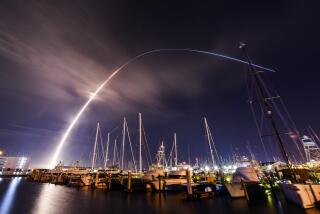Tests Move Atlantis Closer to Secret Satellite Mission
- Share via
KENNEDY SPACE CENTER, Fla. — NASA found Atlantis to be free of dangerous hydrogen leaks during a fueling test Wednesday. The shuttle was cleared for its mission of lifting a satellite, reportedly one that can be used to spy on Iraq.
It was good news for the space agency, which has come under criticism in recent months because of shuttle snags, the Hubble Space Telescope’s flawed mirror and space station design problems.
“We conducted a very successful test. We saw exactly what we expected to see--a good, tight system,” Forrest McCartney, director of the Kennedy Space Center, said.
Launch director Bob Sieck said that small amounts of the highly volatile fuel escaped into Atlantis’ engine compartment and around a 17-inch-diameter valve in plumbing between the orbiter and its external tank, the site of earlier problems. He said the leaks detected were well within safe limits.
The National Aeronautics and Space Administration replaced Atlantis’ external tank and connecting fuel lines during the past few months, and installed new seals in the valve.
NASA plans to launch Atlantis around Nov. 9 or 10 with a top-secret military satellite that can track Iraqi forces, sources speaking on condition of anonymity said. The mission was first scheduled for July, but was delayed when the fuel leaks were discovered during testing of the shuttle.
A launching date is to be set after a flight readiness review that begins Monday.
“It’s always nice to have a successful test under your belt,” Sieck said. “That just leaves one more to go, and that’s Columbia. We think we’ve got that one. We’ll know for sure about the middle of next week.”
Columbia, grounded by hydrogen leaks since May, is to undergo a more extensive fueling test next week. Nearly a dozen television cameras will be mounted in the engine compartment to help trace any remaining leaks.
Hydrogen flooded Columbia’s engine compartment during the last launch attempt in mid-September, although no leakage was evident in fuel lines between the orbiter and tank.
More to Read
Sign up for Essential California
The most important California stories and recommendations in your inbox every morning.
You may occasionally receive promotional content from the Los Angeles Times.













